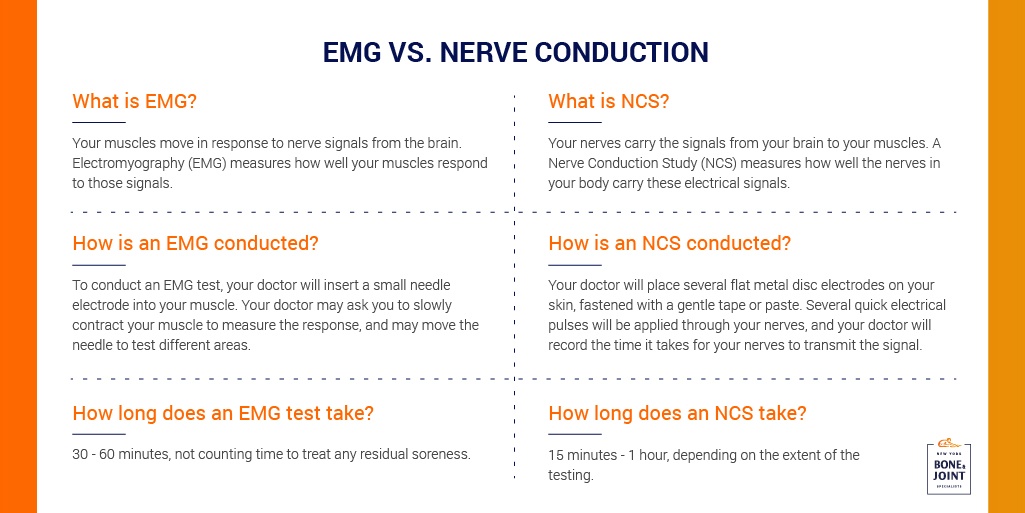WHAT IS AN EMG TEST?
Electromyography, EMG for short, is a technique used to detect atypical nerve patterns, locate nerve injuries and evaluate their extent, and determine an appropriate course of treatment. The test is designed to record electrical activity in the skeletal muscles, since nerve injuries result in abnormal electrical currents.
WHAT IS A NERVE CONDUCTION STUDY?
Much like an EMG test, a nerve conduction study is used to identify peripheral nerve damage. The specialist traces the progress of an electrical current down the nerves to locate any disruptions or other symptoms of a nerve injury.
EMG VS. NERVE CONDUCTION

WHY EMG AND NERVE CONDUCTION STUDIES ARE PERFORMED
EMGs will help a doctor determine the possible causes of a variety of muscle abnormalities. Symptoms that may cause a doctor to perform an EMG, usually accompanied by a Nerve Conduction Study, include:
The EMG and Nerve Conduction Studies will either rule out or pinpoint a problem or medical condition that may be occurring in the nerve paths along a patient’s muscles. These most commonly include:
- Peripheral nerve damage (arms and legs)
- Thoracic outlet syndrome
- Peripheral nerve disorders, such as carpal tunnel syndrome
- Muscular disorders, such as muscular dystrophy
- Disorders of motor neurons, such as sclerosis or polio
- Disorders in nerve roots, such as a herniated discs
- Inflammation of muscles
- Diseases of muscle nerve roots, such as myasthenia gravis
- Pinched nerves (radiculopathy) or nerve compression
PROCEDURES
EMG Procedure
An EMG test is usually performed by directly inserting an electrode needle into a muscle and recording electrical impulses. These impulses, transmitted by motor neurons, are used to control muscle relaxation and contraction. The patient may be asked to contract and relax muscles while the needles are inserted to promote the flow of the current.
Nerve Conduction Study Procedure
Nerve conduction studies are generally performed by applying electrodes to the skin. The first electrode generates an electrical current that travel down the nerves, while the second records the current’s progress. An EMG specialist can examine the data produced by the second electrode to chart any irregularities in the current’s path.
RESULTS:
EMG Test Results
An EMG records electrical patterns as a graph, which your specialist can use to identify the cause of the abnormal neural activity and recommend a course of treatment. In most cases, the activity is the result of nerve or muscle dysfunction or weakened communication between the muscle and the nerve.
Nerve Conduction Study Results
Nerve conduction studies are used to determine the nerve conductive velocity (NCV): the speed with which an electric current travels through a nerve. While the nerve conductive velocity can differ among individuals, and even among nerves, a lower NCV usually suggests nerve damage.
A nerve conduction study can rule out the following conditions: radiculopathy (pinched nerves in the neck or back), peripheral neuropathy (as seen in diabetics), and peripheral nerve entrapments (such as carpal tunnel syndrome).
_________________________________
EXPERIENCING PAIN? DO YOU HAVE AN INJURY?
Our Specialists are here to help.
Book an appointment with NYC’s best orthopedic specialists to discuss your condition. Fill out the form below and you will receive a call from our office within 5-10 minutes. We’ll book an appointment at a time and location that work for you, and send you a reminder by email.
EMG FAQs
What are EMG and nerve conduction studies (NCS), and why are they done?
EMG (electromyography) measures the electrical activity of muscles, both when resting and when contracting, while NCS tests how fast and well nerves conduct electrical signals. Together, they help diagnose whether symptoms (like numbness, tingling, muscle weakness, or pain) stem from nerve damage, muscle disease, or issues at the junction between nerve and muscle.
How should I prepare for an EMG/NCS test?
You do not need to fast beforehand. Wear loose, comfortable clothing that allows access to the areas being tested. Avoid applying lotions or oils on your skin (especially where electrodes will be placed). Also inform your provider if you are taking blood thinners, have a pacemaker, or have any bleeding disorders, as extra care may be needed.
What does the testing feel like, and what side effects should I expect?
During NCS, you may feel mild electrical pulses or tingling; during EMG, small thin needles are inserted into muscles, which can cause brief discomfort. After the test, muscles might feel sore for a few days; minor bruising at needle sites is possible. Serious complications are rare. Most people resume normal activities right away.
How long will results take, and how are they used to guide treatment?
The test itself typically lasts about 30-90 minutes depending on how many muscles and nerves are being evaluated. Afterward, results are interpreted by a physician and sent to your referring provider, often within 1-2 days. The findings help confirm the location and severity of nerve or muscle problems, guide whether treatments like physical therapy, medication, injections, or surgery are needed, and help predict recovery potential.










